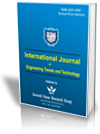Sustainable Digital Transformation: AI Applications in Modern Banking Services
Sustainable Digital Transformation: AI Applications in Modern Banking Services |
||
 |
 |
|
| © 2025 by IJETT Journal | ||
| Volume-73 Issue-10 |
||
| Year of Publication : 2025 | ||
| Author : Mohd Arif Hussain, Sudha Vemaraju, Sarvani Kocherlakota | ||
| DOI : 10.14445/22315381/IJETT-V73I10P125 | ||
How to Cite?
Mohd Arif Hussain, Sudha Vemaraju, Sarvani Kocherlakota,"Sustainable Digital Transformation: AI Applications in Modern Banking Services", International Journal of Engineering Trends and Technology, vol. 73, no. 10, pp.327-343, 2025. Crossref, https://doi.org/10.14445/22315381/IJETT-V73I10P125
Abstract
The banking sector in this tech era provides digital services enabled by Artificial Intelligence (AI) technology to gain a competitive advantage and offer customized and personalized banking services. Focusing on sustainable development and leveraging new technologies is essential to digitalize banking services. The study intends to demonstrate exactly how AI technology has a noteworthy influence on customer satisfaction and loyalty in digital banking for long-term growth and environmental sustainability. The desired outcome of the study is the development of a conceptual model by applying the Technology Acceptance Model (TAM) theory that connects these themes through a theoretical framework with the modified service quality dimensions (Reliability, Assurance, Customization, Empathy, and Responsiveness) and the altered AI technology acceptance elements (Perceived usefulness, Perceived ease of use, Perceived risk, Perceived trust, and Perceived benefit). The study gathered 278 valid responses from banking customers using a purposive sampling strategy and a structured questionnaire. Software tools SMARTPLS4 and SPSS29 are used to measure the model. The findings indicate that the altered AI technology factors and service quality aspects are fulfilling the threshold limits of respective statistical tests conducted in the study, resulting in improved user satisfaction and encouraging users to keep using AI-enabled digital banking. This research explores future directions, develops a model and theory, and offers helpful advice to researchers, practitioners, and environmentalists to enhance digital banking research and environmental sustainability.
Keywords
Artificial Intelligence, Sustainability, Technology Acceptance Model, Service Quality Dimensions, Customer Loyalty.
References
[1] Aarti Sharma, and Nidhi Piplani, “Digital Banking in India: A Review of Trends, Opportunities and Challenges,” International Research Journal of Management Science and Technology, vol. 8, no. 1, pp. 167-179, 2017.
[Google Scholar] [Publisher Link]
[2] Colin Allen, Iva Smit, and Wendell Wallach, “Artificial Morality: Top-Down, Bottom-Up, and Hybrid Approaches,” Ethics and Information Technology, vol. 7, no. 3, pp. 149-155, 2005.
[CrossRef] [Google Scholar] [Publisher Link]
[3] Richard P. Bagozzi, Youjae Yi, and Johann Baumgartner, “The Level of Effort Required for Behavior as a Moderator of the Attitude-Behavior Relation,” European Journal of Social Psychology, vol. 20, no. 1, pp. 45-59, 1990.
[CrossRef] [Google Scholar] [Publisher Link]
[4] Harvir S. Bansal, P. Gregory Irving, and Shirley F. Taylor “A Three-Component Model of Customer Commitment to Service Providers,” Journal of the Academy of Marketing Science, vol. 32, no. 3, pp. 234-250, 2004.
[CrossRef] [Google Scholar] [Publisher Link]
[5] Josée Bloemer, Ko de Ruyter, and Pascal Peeters, “Investigating Drivers of Bank Loyalty: The Complex Relationship Between Image, Service Quality and Satisfaction, Journal of Bank Marketing, vol. 16, no. 7, pp. 276-286, 1998.
[CrossRef] [Google Scholar] [Publisher Link]
[6] William Boulding et al., “A Dynamic Process Model of Service Quality: from Expectations to Behavioral Intentions,” Journal of Marketing Research, vol. 30, no. 1, pp. 7-27, 1993.
[CrossRef] [Google Scholar] [Publisher Link]
[7] Fred D. Davis, “Perceived Usefulness, Perceived Ease of use, and user Acceptance of Information Technology, MIS Quarterly, vol. 13, no. 3, pp. 319-340, 1989.
[CrossRef] [Google Scholar] [Publisher Link]
[8] Karen M. Douglas, Robbie M. Sutton, and Aleksandra Cichocka, “The Psychology of Conspiracy Theories,” Current Directions in Psychological Science, vol. 26, no. 6, pp. 538-542, 2017.
[CrossRef] [Google Scholar] [Publisher Link]
[9] Yogesh K. Dwivedi et al., “Re-examining the Unified Theory of Acceptance and Use of Technology (UTAUT): Towards a Revised Theoretical Model,” Information Systems Frontiers, vol. 21, no. 3, pp. 719-734, 2017.
[CrossRef] [Google Scholar] [Publisher Link]
[10] Financial Stability Board, Artificial Intelligence and Machine Learning in Financial Services, 2017. [Online]. Available: https://www.fsb.org/2017/11/artificial-intelligence-and-machine-learning-in-financial-service/
[11] Claes Fornell, and David F. Larcker, “Evaluating Structural Equation Models with Unobservable Variables and Measurement Error,” Journal of Marketing Research, vol. 18, no. 1, pp. 39-50, 1981.
[CrossRef] [Google Scholar] [Publisher Link]
[12] Celine Herweijer, Benjamin Combes, and Jonathan Gillham, “How AI can Enable a Sustainable Future,” Pwc, Microsoft, pp. 1-51, 2019.
[Google Scholar] [Publisher Link]
[13] Dwayne D. Gremler, Kevin P. Gwinner, and Stephen W. Brown, “Generating Positive Word-of-Mouth Communication through Customer-Employee Relationships,” Journal of Service Management, vol. 12, no. 1, pp. 44-59, 2001.
[CrossRef] [Google Scholar] [Publisher Link]
[14] Joseph F. Hair, Multivariate Data Analysis, DigitalCommons@Kennesaw State University, 2009.
[Google Scholar] [Publisher Link]
[15] Joseph F. Hair, Christian M. Ringle, and Marko Sarstedt, “Partial Least Squares Structural Equation Modeling: Rigorous Applications, Better Results and Higher Acceptance,” Long Range Planning, vol. 46, no. 1-2, pp. 1-12, 2013.
[CrossRef] [Google Scholar] [Publisher Link]
[16] Hartmut Hoehle, Sid Huff, and Sigi Goode, “The Role of Continuous Trust in Information Systems Continuance,” Journal of Computer Information Systems, vol. 52, no. 4, pp. 1-9, 2015.
[Google Scholar] [Publisher Link]
[17] Michael Haenlein, Andreas M. Kaplan, and Anemone J. Beeser, “A Model to Determine Customer Lifetime Value in a Retail Banking Context,” European Management Journal, vol. 25, no. 3, pp. 221-234, 2007.
[CrossRef] [Google Scholar] [Publisher Link]
[18] Henry F. Kaiser, “An Index of Factorial Simplicity,” Psychometrika, vol. 39, no. 1, pp. 31-36, 1974.
[CrossRef] [Google Scholar] [Publisher Link]
[19] Sonia Katyal, “Private Accountability in the Age of Artificial Intelligence,” UCLA Law Review, vol. 66, pp. 54-141, 2019.
[Google Scholar] [Publisher Link]
[20] Kadircan H. Keskinbora, and Kader Keskinbora, “Ethical Considerations on Novel Neuronal Interfaces,” Neurological Sciences, vol. 39, no. 4, pp. 607-613, 2017.
[CrossRef] [Google Scholar] [Publisher Link]
[21] Kottler Philip, Kevin Lane Keller, and Alexander Chernev, Marketing Management, 16th ed., Pearson Canada, 2022.
[Google Scholar] [Publisher Link]
[22] Christopher H. Lovelock, Paul Patterson, and Jochen Wirtz, Services Marketing, 6th ed, Pearson Australia, 2015.
[Google Scholar] [Publisher Link]
[23] Lynn Margherio et al., The Emerging Digital Economy II, U.S. Department of Commerce, 1998.
[Google Scholar]
[24] John McCarthy, “From Here to Human-Level AI, Artificial Intelligence, vol. 171, no. 18, pp. 1174-1182, 2007.
[CrossRef] [Google Scholar] [Publisher Link]
[25] Christine Moorman, Gerald Zaltman, and Rohit Deshpande, “Relationships Between Providers and Users of Market Research: The Dynamics of Trust Within and Between Organizations,” Journal of Marketing Research, vol. 29, no. 3, pp. 314-328, 1992.
[CrossRef] [Google Scholar] [Publisher Link]
[26] Allen Newell, J.C. Shaw, and Herbert A. Simon, “Elements of a Theory of Human Problem Solving,” Psychological Review, vol. 65, no. 3, pp. 151-166, 1958.
[CrossRef] [Google Scholar] [Publisher Link]
[27] Richard L. Oliver, Satisfaction: A Behavioral Perspective on the Consumer, 2nd ed., Routledge, New York, 2010.
[CrossRef] [Google Scholar] [Publisher Link]
[28] Richard L. Oliver, “Whence Consumer Loyalty?” Journal of Marketing, vol. 63, no. 4 (Suppl-1), pp. 33-44, 1999.
[CrossRef] [Google Scholar] [Publisher Link]
[29] A. Parasuraman, L. Berry, and V. Zeithaml, “SERVQUAL: A Multiple-Item Scale for Measuring Consumer Perceptions of Service Quality,” Journal of Retailing, vol. 64, no. 1, pp. 12-40, 1988.
[Google Scholar]
[30] A. Parasuraman, L. Berry, and V. Zeithaml, “Refinement and Reassessment of the SERVQUAL Instrument,” Journal of Retailing, vol. 67, no. 4, pp. 420-450, 1991.
[Google Scholar]
[31] Valarie A. Zeithaml, Leonard L. Berry, and A. Parasuraman, “The Behavioral Consequences of Service Quality,” Journal of Marketing, vol. 60, no. 2, pp. 31-46, 1996.
[CrossRef] [Google Scholar] [Publisher Link]
[32] Valarie A. Zeithaml, A. Parasuraman, and Arvind Malhotra, “Service Quality Delivery Through Websites: A Critical Review of Extant Knowledge, Journal of the Academy of Marketing Science, vol. 30, no. 4, pp. 362-375, 2002.
[CrossRef] [Google Scholar] [Publisher Link]
[33] Jon M. Peha, and Ildar M. Khamitov, “PayCash: A Secure, Efficient Internet Payment System,” ICEC '03: Proceedings of the 5th International Conference on Electronic Commerce, Pittsburgh, Pennsylvania, USA, pp. 125-130, 2003.
[CrossRef] [Google Scholar] [Publisher Link]
[34] Chatura Ranaweera, and Jaideep Prabhu, “The Influence of Satisfaction, Trust, and Switching Barriers on Customer Retention in a Continuous Purchasing Setting,” Journal of Service Management, vol. 14, no. 4, pp. 374-395, 2003.
[CrossRef] [Google Scholar] [Publisher Link]
[35] Stuart Jonathan Russell, and Peter Norvig, Artificial Intelligence: A Modern Approach, Prentice Hall, 1995.
[Google Scholar]
[36] Tianxiang Sheng, and Chunlin Liu, “An Empirical Study on the Effect of E-Service Quality on Online Customer Satisfaction and Loyalty, Nankai Business Review International, vol. 1, no. 3, pp. 273-283, 2010.
[CrossRef] [Google Scholar] [Publisher Link]
[37] Syed Ali Raza et al., “Internet Banking Service Quality, E-Customer Satisfaction and Loyalty: The Modified E-SERVQUAL Model,” The TQM Journal, vol. 32, no. 6, pp. 1443-1466, 2020.
[CrossRef] [Google Scholar] [Publisher Link]
[38] Bart Van Looy et al., “Dealing with Productivity and Quality Indicators in a Service Environment: Some Field Experiences,” International Journal of Service Industry Management, vol. 9, no. 4, pp. 359-376, 1998.
[CrossRef] [Google Scholar] [Publisher Link]
[39] Ricardo Vinuesa et al., “The Role of Artificial Intelligence in Achieving the Sustainable Development Goals,” Nature Communications, vol. 11, no. 1, pp. 1-10, 2020.
[CrossRef] [Google Scholar] [Publisher Link]
[40] Bert Weijters et al., “Customers’ Usage of Self-Service Technology in a Retail Setting,” Vlerick Leuven Gent Working Paper Series, 2005.
[Google Scholar]
[41] H. James Wilson, and Paul R. Daugherty, “Collaborative Intelligence: Humans and AI are Joining Forces,” Harvard Business Review, vol. 96, no. 4, pp. 114-123, 2018.
[Google Scholar] [Publisher Link]
[42] Longfei Yang, et al., “The Effects of Psychological Stress on Depression,” Current Neuropharmacology, vol. 13, no. 4, pp. 494-504, 2015.
[CrossRef] [Google Scholar] [Publisher Link]
[43] Han Yu et al., “Building Ethics into Artificial Intelligence,” Proceedings of the 27th International Joint Conference on Artificial Intelligence, Stockholm, pp. 5527-5533, 2018.
[CrossRef] [Google Scholar] [Publisher Link]
[44] Valarie Zeithaml et al., Service Marketing: Integrating Customer Focus Across the Firm, 8th ed., McGraw-Hill/Irwin, 2024.
[Google Scholar] [Publisher Link]

